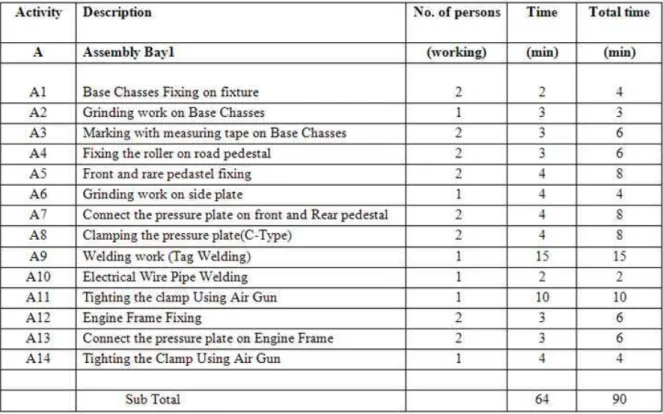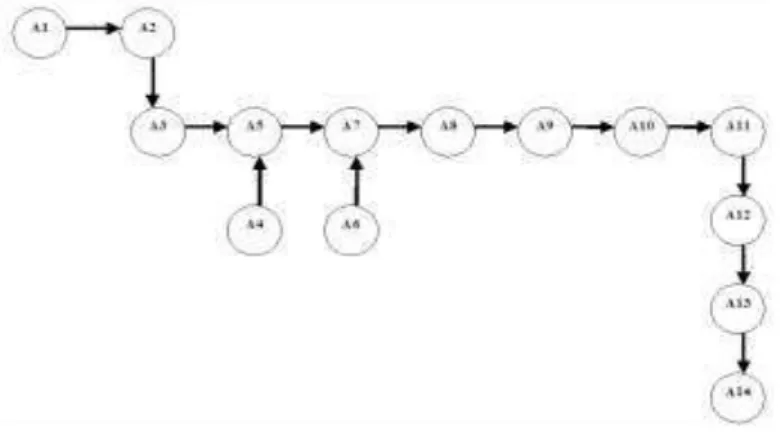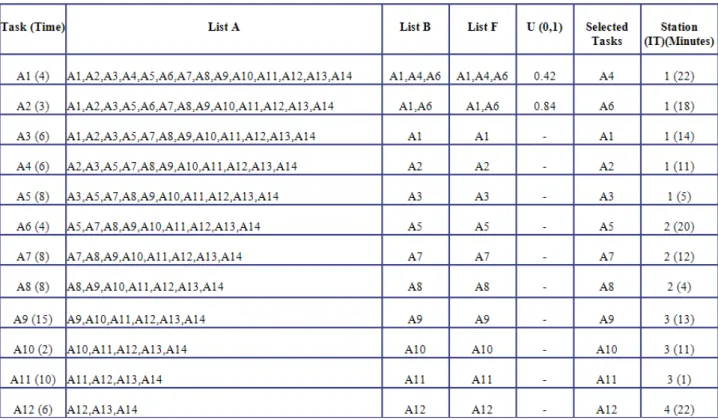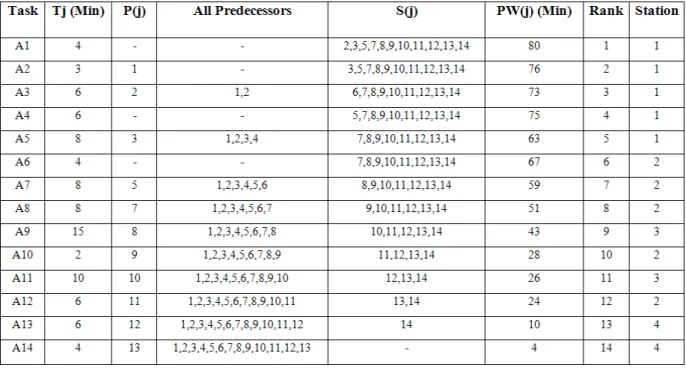22
1. INTRODUCTION
Assembly line balancing (ALB) relates to a finite set of work elements or tasks, each having an operation processing time and a set of precedence relations, which specify the permissible orderings of the tasks. One of the problems in organizing mass production is how to group work tasks to be performed on workstations so as to achieve the desired level of performance.
Line balancing is an attempt to allocate equal amounts of work to the various workstations along the line. The fundamental line balancing problem is how to assign a set of tasks to an ordered set
An Optimal Balancing Of Multiple Assembly Line
For A Batch Production Unit
M. Mohan Prasad Assistant Professor,
Department of Mechanical Engineering, P. A. College of Engineering and Technology, Pollachi - 642 002, Coimbatore - Dt, Tamil Nadu, India.
profmmohanprasad@gmail.com
K. Ganesan
Associate Professor,
Department of Mechanical Engineering, PSG College of Technology,
Peelamedu, Coimbatore - 641 004, Tamil Nadu, India.
R.K.Suresh,
Principal,
Department of Mechanical Engineering,
Ahalia School of Engineering and Technology,
Palakkad - 678 557,
A B S T R A C T K E Y W O R D S
A R T I C L E I N F O
Assembly line balancing; COMSOAL; RPW
Received May 2013 Accepted July 2013
Available online December 2013 Higher Productivity in organizations leads to national
prosperity and better standard of living for the whole community. This has motivated several workers on productivity improvement at different levels of XXXX India Pvt Ltd, Chennai. The main objective of this project is to increase the production by changing the layout of the assembly line in making of Transmit Mixer. At present 12 machines are being manufactured in a total of 2 shifts per day. Time study is carried out to identify and avoid the idle time to increase the production rate to 24 machines per day. The organization facing the problems like production time, online inventory, delay and idle time. Here our objective is to reduce the idle time, identifying the cycle time and optimal method of production. The COMSOAL (Computer Method for Sequencing Operations for Assembly Lines) and RPW (Ranked Positional Weight) algorithms have been used to get the optimal solution. This algorithm provides the better solution, thereby reducing unnecessary movements of the worker within the station. The overall cycle time got reduced when compared with the existing cycle time in order to meet the customer demand. Thus we are proposing this scientific approach to get the optimal solution for increased rate of production of the company without affecting the quality and cost.
23 of workstations, such that the precedence relations are satisfied and some measure of performance is optimized.
1.1 PROBLEM STATEMENT
The main objective of this project is to increase the production by changing the layout of the assembly line in making of Transmit Mixer. At present 12 machines are being manufactured in a total of 2 shifts per day. Time study is carried out to identify and avoid the idle time to increase the production rate to 24 machines per day. The organization facing the problems like production time, online inventory, delay and idle time. Here our objective is to reduce the idle time, identifying the cycle time and optimal method of production.
2. LINE BALANCING
Although the product layout produce a large volume of goods in a relatively short time once the line is established there are numerous problems that arise in connection with this type of layout that do not become important in the process layout. One of the complex problems is the problem of line balancing, which may be considered the problem of balancing operations or stations in terms of equal times and times required to meet the desired rate of production. In practical cases perfect balance is achieved in straight line layouts.
The problem in line balancing is minimizing the idle time on the lin e for all combinations of workstations subject to certain restrictions. An important restriction is the production volume that is to be produced. If the demands of the product change, then there should be a change in line balancing. Usually an assembly line is used for a variety of products, it becomes necessary to consider a fixed a fixed number of workstations.
In general, there are two types of line-balancing situations, each of which involves different considerations. It is sometimes difficult in practical cases to distinguish between the two categories, but it is useful to consider the line balancing problem as Assembly -line balancing and Fabrication-line balancing: The distinction refers to the type of operations taking place on the line to be bala e. The te asse ly li e has gai ed a e tai popular interpretation as it used with the reference to the automotive industry. The term fa i atio li e , o the othe ha d i plies a p odu tio li e ade up of ope atio s that form or change the physical or chemical characteristics of the product involved. Machining operation would fit into this classification, as would heat - treating operation.
2.1 HEURISTIC METHODS OF LINE BALANCING
In this section, we described several methods for solving line balancing problems. These methods are heuristic approaches, meaning that they are based on logic and common sense rather than on a mathematical proof. None of the methods guarantees an optimal solution, but they are likely to result in good solutions which approach the true optimum.
To get optimal solution we consider two different algorithms namely
COMSOAL (Computer Method of Sequencing Operation for Assembly Lines) RPW(Ranked Positional Weight)
2.2 COMSOAL:
24 sampling. A large number of feasible solution can be generated the essential idea behind
COMSOAL is the random generated of a feasible sequence. Such a sequence may be constructed by assigning a positive probability of selection to each task that will fit in the current time and then selecting one of the tasks at random. The procedure is repeated until all the tasks have been assigned.
Generate a random solution satisfying all constraints, storing the number of stations it needs. Repeat this random generation process, keeping the best solution, and discarding poor ones. The second stage can be aborted if a partial solution is already worse than a previous (better) solution.
2.2.1 ALGORITHM
The COMSOAL program proceeds in 6 steps as follows:
STEP 1: For each task identify those tasks which immediately follow it in precedence orders.
STEP 2: Place in LIST A for each task in the assembly, the total number of tasks which immediately precede it in the precedence diagram.
STEP 3: From LIST A, create LIST B composed of the tasks which have zero predecessors. If no tasks remain unassigned to stations, then stop
STEP 4: From LIST B, create LIST C composed of the tasks whose performance times are no greater than the available time at the station. If LIST C is empty, open a new station with the full cycle time available and go through STEP 4 again.
STEP 5: Randomly select from LIST C a task for assignment to the station.
STEP 6: Update the time available at the station and LIST B to reflect the time consumed and the completed predecessors at this stage. If LIST B is empty update LIST A and return to STEP 3 otherwise return to STEP 4.
2.3 RPW:
It o i es the st ategies of la gest a didate ule a d Kil idge a d Weste s method. It is a rapid approximate method which has been shown to provide acceptable good solution more quickly than many alternative methods. It is capable of dealing with both precedence and zoning constraints.
This is another popular heuristic approach to solving line balancing problems for assembly lines. The basic idea is to allot tasks to stations based on their priority. The priority is determined by the total time needed by the task and its successors.
The logic is simple: If we have a large number of tasks from which we can choose to assign to a station, we are more likely to find a (combination) that will minimize the idle time.
From the above, it follows that if we minimize idle time at each station, we should end up with the minimum number of stations.
2.3.1 ALGORITHM:
The RPW program proceeds in 7 steps as follows:
25 STEP 2: Place in P (j) for position of tasks.
STEP 3: Create all predecessors composed of the tasks which have zero predecessors. STEP 4: From all predecessors, Create S (j) all the successors of the tasks.
STEP 5: From successors, Create PW (j) by adding all the times in the Successor tasks. STEP 6: From PW (j) , Create the rank list by giving the rank in descending order.
STEP 7: From the rank, the stations are assigned in the ascending order of the rank. In each station specified time will be given. If the work goes beyond the specified time then the new station will be introduced for the further work and repeat STEP 7 again.
3. SCOPE OF THE PROJECT
Due to implementation of batch production method, productivity depreciation and other certain problems will arise. So in order to improve our productivity we are going to implement and analysis continuous production technique by using Line Balancing method.
3.1 INPUT VARIABLES
In order to determine a proper line balancing, assembly or fabrication, the following information is needed.
Production Volume
List of operations and their sequence
Time required completing each operation as well as the elemental time value
The production volume should be determined by sales or marketing group. Of course the production line output must satisfy the demand. A fixed production rate is determined with the production volume and the time period involved. The list of operations and their sequence should be established prior to considering the line-balancing problem. The time for various operations, constitute probably the most important piece of information of all in the line-balancing problem.
3.2 REQUIREMENTS
Material shortage should not occur. Availability of the worker should be 100 %. The employee should work to his full potential.
All the required accessories should be withi the o ke s ea h
3.3 CONSTRAINTS USED IN ALBP
Task Grouping and Task splitting Resource Dependent Task Times Incompatible Task Assignments
Temporary tasks with unknown durations Work Zone (line side) related constraints Operator related constraints
Ergonomic constraints Reduction of work overload Reduction of task dispersion
Throughput improvement and scrap reduction Dynamic line balancing (DLB)
26 12 Machines per shift.2 Shift per day (8 Hours per shift).
Efficiency of the worker is taken as 70%.
Production time = hours per shift * efficiency of worker = 8*70%
= 5.6 Hours. = 336 Minutes.
Production volume = number of machine per shift. Cycle time = production time / production volume = 336 /12
= 28 Minutes.
4. TIME STUDY FOR CHASSIS ASSEMBLY UNIT
In this section, they are assembling the basic supporting materials of the mixer such as, fixing of Base chasses on the fixture, front and rear pedestal fixing, Engine frame fixing, welding work (tag welding).
Time study table includes various activities required for finishing the particular Chassis assembly unit and time required for implementing each activity is given as follows.
Table 1: Time study for Chassis assembly unit
4.1 FLOW DIAGRAM
27
Fig. 1: Flow diagram for Chassis assembly unit
4.2 COMSOAL APPROACH
As a solution method, COMSOAL quickly generates multiple feasible solutions and uses the best solution as its final reported result. To appear on this list, activities must have met all precedence requirements and there must be enough resources available to assign to the activity. The next activity to be scheduled is randomly chosen from this availability list and a new availability list is generated.
28
Table 2: COMSOAL Algorithm used in Chasses Assembly Unit
4.2.1 PROPOSSED LAYOUT
The proposed layout of activities which are carried out in each and every station is given below.
29
4.2.2 IDLE TIME CALCULATION:
Number of Stations: 4 Idle Time:
Station 1 : 05 Minutes Station 2 : 04 Minutes Station 3 : 01 Minutes Station 4 : 12 Minutes
Total : 22 Minutes
% Idle TIME = 22 Min / 4 Station * 28 Minutes = 19.6 %
The best solution must have (K) number of stations, Where,
K = Total time of all tasks / cycle time = 90/28
= 3.21 = 3
Therefore 3 is the Minimum Number of Station
4.3 RPW APPROACH
It o i es the st ategies of la gest a didate ule a d Kil idge a d Weste s method. This is another popular heuristic approach to solving line balancing problems for assembly lines. The basic idea is to allot tasks to stations based on their priority. The priority is determined by the total time needed by the task and its successors.
It o i es the st ategies of la gest a didate ule a d Kil idge a d Weste s ethod. F o the above, it follows that if we minimize idle time at each station, we should end up with the minimum number of stations.
30 The following table shows station assigning by RPW method.
Table 4: Station assigning table
4.3.1 PROPOSED LAYOUT:
The proposed layout of activities which are carried out in each and every station is given below.
Fig. 3: Proposed Layout diagram
4.3.2 IDLE TIME CALCULATION
Total Idle time per cycle equals sum of station idle time
Idle time For the 4 stations = 5+ 4+ 1+ 12 = 22 min % Idle time = 22min / (4 stations)(28 min/station)
= 19.64%
The theoretical lower bound is sum of process times divided by the required cycle time (Tc) = 80/28
= 2.85 = 3 station
Therefore 3 is the minimum number of station
31 Company was assembling 6 machines per shift. Now it has been increased to 12 machines per shift, this is done by high utilization of the idle time. In future number of machines getting assembled can be extended to company need. Currently products are getting assembled by manually; In future it can be achieved by using automatic robots.
Thus the production is increased by changing the assemble line system which is proposed to be a continuous production system. The time study and cycle time calculations are carried out such that the production rate is increased to 24 machines per day. In order to overcome the problems of depreciation in productivity, idle time, improper working schedule and lagging of material handling equipments due to implementation of batch production system, the continuous production is proposed to be implemented. The continuous production system is implemented by using the optimal line balancing method. Algorithm provides the better solution, thereby reducing idle time, reducing unnecessary movements of worker within the station, and also the productivity improvement.
REFERENCES:
Journals:
A us, A.L., COM“OAL: A Co pute Method of “e ue i g Ope atio s fo Asse ly Li es, International Journal of Production Research, Vol. 4, No. 4, 1966
A e , M. Heu isti ethods fo ost-oriented assembly line balancing: A comparison on solutio uality a d o puti g ti e . I t. Jou al of P odu tio E o o i s, ol. , -264, 2001.
A de so , E. J. a d Fe is, M. C., , Ge eti Algo ith s fo Co i ato ial Opti izatio : The Asse ly Li e Bala i g P o le , U i e sity of Cambridge, Cambridge, England.
D . ‘o e t G a es, A ‘e ie of Li e Bala i g fo Flo Li es , Pe spe ti es o Mate ial Handling Practice, 1992
Books:
32 Sa so Eilo , Ele e ts of p odu tio pla i g a d o t ol , U i e sal Book Co p .
K.C.Jai &L.N.Agga al, P odu tio Pla i g Co t ol a d I dust ial Ma age e t , Kha a Publishers, 1990.
“.K. Haj a Choudhu y, a d A.K. Haj a Choudhu y, P odu tio Ma age e t , Media Promoters and Publishers Pvt. Ltd., 1998.
N.G. Nai , P odu tio a d Ope atio s Ma age e t , Tata M G a Hill, .
“.N.Cha y, Theo y a d P o le s i P odu tio & Ope atio s Ma age e t , Tata M G a Hill, 1995.




